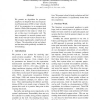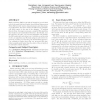3096 search results - page 16 / 620 » Theory and Use of the EM Algorithm |
EACL
2009
ACL Anthology
14 years 9 months ago
2009
ACL Anthology
We present an algorithm for pronounanaphora (in English) that uses Expectation Maximization (EM) to learn virtually all of its parameters in an unsupervised fashion. While EM freq...
KDD
2006
ACM
14 years 9 months ago
2006
ACM
We introduce a new EM framework in which it is possible not only to optimize the model parameters but also the number of model components. A key feature of our approach is that we...
JMLR
2002
13 years 8 months ago
2002
We examine the learning-curve sampling method, an approach for applying machinelearning algorithms to large data sets. The approach is based on the observation that the computatio...
CVPR
2006
IEEE
14 years 2 months ago
2006
IEEE
This paper describes an algorithm for pose and illumination invariant face recognition from a single image under occlusions. The method iteratively estimates the parameters of a 3...
CIKM
2011
Springer
12 years 8 months ago
2011
Springer
Entity matching (EM) is the task of identifying records that refer to the same real-world entity from different data sources. While EM is widely used in data integration and data...


